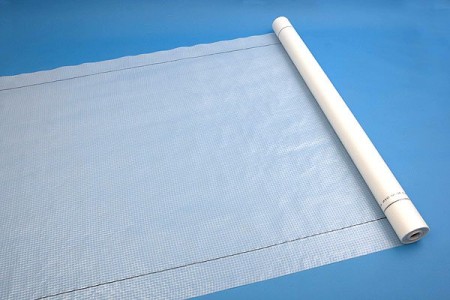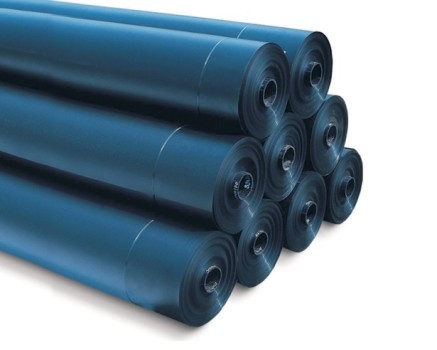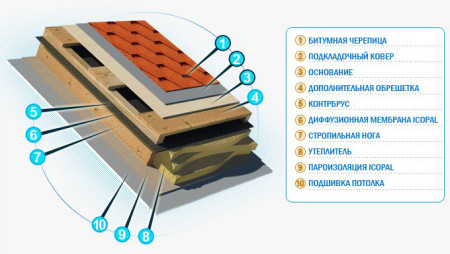In order that moisture in the form of precipitation does not fall into the under-roof space and does not destroy the heater and rafter structures, use hydro- and vapor-insulating films and membranes. These materials are also important components of the roof ventilation system. Therefore, their choice should be taken very seriously. In this article we will look at the types of protective films, we will tell about the materials from which they are made, and also we will consider the spheres of application of each kind of film for the under-roof space.
Content
- 1 Steam insulation films
- 2 Waterproofing foil for roofing
- 3 Anti-condensation waterproofing films
- 4 Diffusion and super diffusion membranes
- 5 Separation volume diffusion membranes
- 6 Roofing from bituminous shingles
- 7 Metal roofing
- 8 Roof from composite metal with an internal acrylic covering
- 9 Roofing from natural tiles
- 10 Slate roofing
- 11 Roof from the euro-slate
- 12 Roof coverings
- 13 Shale roofing
Steam insulation films
The vapor-insulating material is installed in the under-roof space of the insulated roof. Steam insulation film is intended, first of all, to protect the heater from moisture and steam rising from the bottom, from the living quarters of the house.
When installing, it is very important to make all joints between the film sheets sealed. The same applies to the places where the film adjoins the roof structures. If the joints are sealed for any reason, the moisture from the living rooms will penetrate into the thermal insulation layer and begin to gradually destroy it.
When choosing a vapor barrier film, ask the seller-consultant for the vapor permeability of the material. The lower this indicator, the better the material and the better the vapor barrier. Also, do not try to save on the waterproofing for the roof and try to replace it with analogs. So, waterproofing film for the floor is not recommended for installation under the roof.
Waterproofing foil for roofing
This material can be used with almost any roofing material. The water vapor permeability of the waterproofing film is much lower than that of the insulation, so when mounting it, several ventilation gaps are made. Of the advantages of this material can be noted, in the first place, a small cost.
However, before you decide on this material, you should think about the expediency of using it. Since the waterproofing film works only in the presence of ventilation gaps, in some cases it will be better to install a membrane.
The lower ventilation gap for the waterproofing film is provided by installing an additional crate, which is fastened over the rafters. Thus, more wood and consumables are used: fasteners, antiseptics, etc. Also increases the time for the installation of the roofing "pie".
Waterproofing film - the most inexpensive option insulation of insulated roofs (compared to membranes), it protects well the insulation of the ceiling of the upper floor from the penetration of moisture. If you lay a membrane on a non-insulated roof, some of its properties will not be used, so a perforated waterproofing film is the best option for "cold" roofs.
If we talk about the shortcomings of this material, it should be noted, in the first place, increased labor input of installation works (installation of an additional crate). It is also undesirable to use a waterproofing film on the roofs of a complex shape, where there are, say, several valleys, dormers, several levels, etc. In this case, it will be difficult to ensure normal ventilation of the under-roof space, which is fraught with the appearance of fungi and mold.
When choosing a waterproofing film, first of all it is necessary to focus on the water resistance of the material - the ability to prevent moisture penetration. Water resistance is measured in millimeters of water column. If the water resistance of the film is lower, it is not recommended to install it as a temporary roof, even for a short time, and immediately after the installation of the material it must be protected with roofing material.
It is also necessary to pay attention to the resistance to infrared radiation, since the material is exposed to a constant heat flux. The strength of the material must be at least 150 N / cm2.
Anti-condensation waterproofing films
Used mainly for metal roofing - metal roofing, rebated roofing materials. The side of the film, covered with pile, absorbs moisture, thus preventing its penetration into the interior of the roofing cake. Therefore, it is necessary to ensure good ventilation of the under-roof space, so that moisture evaporates in a timely manner. For this purpose, a lower ventilation gap is made.
An anticondensate film protects the inner surface of the roof from moisture, but it does not save from condensation during the warm season, when the vapors penetrate the roof during the day and are cooled there at night.
When choosing an anticondensate film, one must pay attention to the vapor permeability, which should tend to zero (about 0.3 g / m2 hPa). A film with this index maximally protects the metal roofing material from the effects of condensation and corrosion.
Diffusion and super diffusion membranes
All types of membranes are not used in combination with roofing materials having high thermal conductivity. These include metal tile and Euroshield. Membranes are mainly used with ceramic tiles, european tile, cement-concrete, bituminous tiles, composite metal tiles - the thermal conductivity coefficient of the listed ones is significantly lower than that of metal tiles and Euroshire.
The membranes are installed on roofs having a complex shape, as it is very difficult to make ventilation gaps on such rafter structures with the help of an additional crate. From the advantages of installation, it is necessary to note the necessity of the device of only one ventilation gap - the upper one. Hence the significant savings in materials and time.
However, the issue of the use of membranes in conjunction with eurosiphire is still controversial, and no one makes clear recommendations on this issue. In our case, we were guided by the fact that the Euro-sphere has a high thermal conductivity.
Separation volume diffusion membranes
Used for the installation of metal roofing: copper, zinc, steel, aluminum, etc. In particular, it is recommended for roofing of titanium-zinc on gentle slopes (up to 15%).
Separating membranes well protect the roofing material from condensation due to ventilation, which is provided by a volumetric crate. When installing this type of membrane, only one upper ventilation gap is required, which, by the way, can be provided by the membrane itself.
When choosing separation membranes, the main criterion is vapor permeability. In accordance with European standards, the vapor permeability is evaluated, based on the water vapor resistance thickness index - Sd / the lower this value, the better.
In Russia the vapor permeability of the material is measured in g / m2 per day. Here, on the contrary, the higher this index, the greater the permeability of the material. The optimal figure is 1000 g / m2 per day.
Antikondensate films and membranes, according to professional builders, are most suitable for mansards. The choice of material depends on the type of roof covering.
Thus, diffuse and superdiffuznye membrane is used with only one vent gap (between the roofing material and the membrane) in combination with a roofing material having poor thermal conductivity - natural tile, cement and sand, bitumen, etc.
Volumetric membranes are also mounted with a single ventilation gap for metal roofing materials. Antikondensatnye films are used only with two ventilation gaps - the bottom and top. Mounted under the metal, profiled, Euroshaft.
Below we will consider the application of the listed under-roof waterproofing materials with concrete types of roofing in a heated house.
Roofing from bituminous shingles
As a waterproofing material, it is permissible to use diffusion and superdiffusion membranes with the device of one ventilation gap. It is also possible to mount waterproofing films made of polyethylene or polypropylene, but in this case there should be two ventilation gaps. Once ready rafter framing, waterproofing layer stack top mounted kontrobreshetku, then lathing solid, roofing material, a layer of insulation material and the vapor barrier. Waterproofing films are laid in the same way, regardless of the roofing material
Metal roofing
It is recommended to use anti-condensate film, since the metal tile has a very high thermal conductivity, and the temperature drop at different times condensation on the inner ceiling surface. In this case, it is also possible to use waterproofing films. Categorically it is not recommended to use diffusion membranes. It is acceptable to use special volumetric separation diffusion membranes.
To prevent the accumulation of moisture between the roofing material and the layer of waterproofing, an upper vent clearance of about 40 mm is arranged. Between the layer of heat insulation and waterproofing, ventilation is also made - the lower gap. The inner side of the thermal insulation material is protected by a vapor barrier film. Steam insulation is attached to the rafter with a staple gun. The vapor barrier sheets are lapped. Joints are sealed with adhesive tape.
Roof from composite metal with an internal acrylic covering
As a waterproofing material, superdiffusion and diffusion membranes are recommended for use with only the upper ventilation gap. It is allowed to use waterproofing films - two ventilation gaps are necessary. On the inside, the heat insulator layer is protected with a vapor barrier film.
Roofing from natural tiles
In this case, it is recommended to use superdiffusion and diffusion membranes with a single, upper ventilation gap. It is possible to use waterproofing films. The heat insulator on the inside is protected with a vapor barrier film. When using a waterproofing film, two ventilation gaps are necessary - upper and lower.
Slate roofing
In the case of roofing from asbestos cement sheets, diffusion and superdiffusion membranes with one upper ventilation gap are used. It is acceptable to use waterproofing films with the device of two ventilation gaps. Thermal insulation must be protected from the inside with a vapor barrier film.
Roof from the euro-slate
Evroshifer differs quite high thermal conductivity, and with a difference in temperatures at different times of the day, condensation forms on its internal surface. For this reason, anti-condensation and waterproofing films are recommended as waterproofing. Diffuse membranes are not recommended (although, as we have already noted, this is a controversial issue). It is necessary to have two ventilation gaps - upper and lower. Thermal insulation is protected with vapor barrier.
Roof coverings
Anti-condensate and vapor-tight films are used - two ventilation gaps are necessary. It is permissible to use waterproofing films - perforated and not perforated, from polypropylene or polyethylene with the device of both ventilation gaps. It is inadmissible to use diffusion membranes, except for special volumetric separation waterproofing materials intended for metal rebated roofs.
Shale roofing
Superdiffusion and diffusion membranes with one clearance for ventilation are installed. You can use waterproofing films - polyethylene and polypropylene. This requires the upper and lower ventilation clearances.
In houses that are not heated and in houses with a cold under-roof space, the vapor barrier is not necessary. Mount only waterproofing material.
For this purpose it is recommended to use a waterproofing film perforated from polypropylene or polyethylene.
































